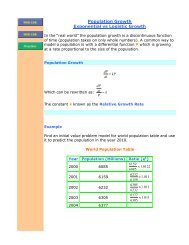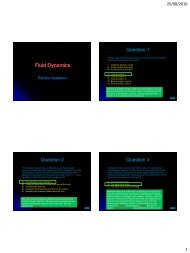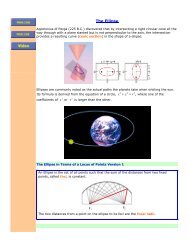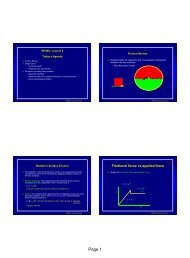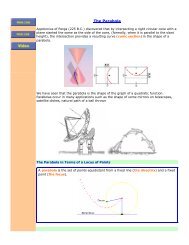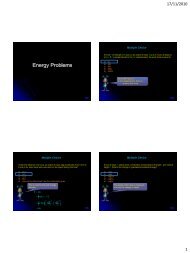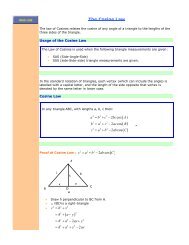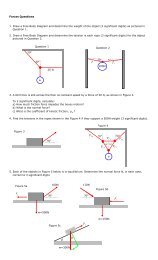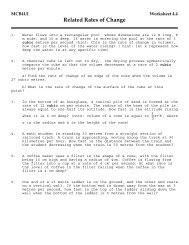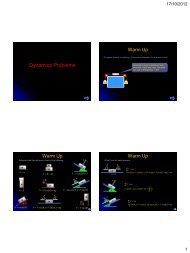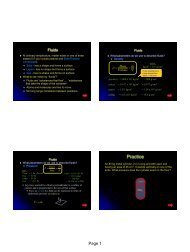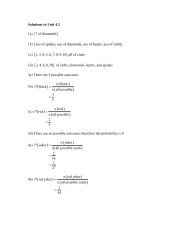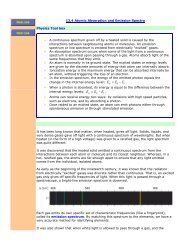Size of the Earth and the Distances to the Moon and Sun
Size of the Earth and the Distances to the Moon and Sun
Size of the Earth and the Distances to the Moon and Sun
You also want an ePaper? Increase the reach of your titles
YUMPU automatically turns print PDFs into web optimized ePapers that Google loves.
Waterloo Collegiate Astronomy AssignmentSES4UI<strong>Size</strong> <strong>of</strong> <strong>the</strong> <strong>Earth</strong> <strong>and</strong> <strong>the</strong> <strong>Distances</strong> <strong>to</strong> <strong>the</strong> <strong>Moon</strong> <strong>and</strong> <strong>Sun</strong>ObjectivesUsing observations <strong>of</strong> <strong>the</strong> <strong>Earth</strong>-<strong>Sun</strong>-<strong>Moon</strong> system <strong>and</strong> elementary geometry <strong>and</strong> trigonometry, <strong>the</strong> studentwill duplicate <strong>the</strong> methods <strong>of</strong> <strong>the</strong> ancient Greek astronomers in determining <strong>the</strong> size <strong>of</strong> <strong>the</strong> <strong>Earth</strong>, <strong>the</strong> size <strong>of</strong><strong>and</strong> distance <strong>to</strong> <strong>the</strong> <strong>Moon</strong>, <strong>and</strong> <strong>the</strong> size <strong>of</strong> <strong>and</strong> distance <strong>to</strong> <strong>the</strong> <strong>Sun</strong>. In doing so, <strong>the</strong> student will derive <strong>the</strong>value <strong>of</strong> <strong>the</strong> astronomical unit, <strong>the</strong> fundamental baseline used for measuring <strong>the</strong> parallaxes <strong>of</strong> stars.Complete <strong>the</strong> Assignment by following <strong>the</strong> guides <strong>and</strong> filling in <strong>the</strong> material as required. You may want <strong>to</strong>use a separate answer sheet <strong>to</strong> show you work <strong>and</strong> answer questions if you require more space.Materials‣ Scientific calcula<strong>to</strong>rs‣ rulersIntroductionAs we look in<strong>to</strong> <strong>the</strong> night sky, <strong>the</strong> <strong>Moon</strong>, planets, <strong>and</strong> stars appear <strong>to</strong> be set within a crystalline sphere. Weobserve <strong>the</strong> motion <strong>of</strong> <strong>the</strong>se objects from night <strong>to</strong> night during <strong>the</strong> course <strong>of</strong> a year <strong>and</strong> discover predictablepatterns. The <strong>Sun</strong>, our star, reliably rises <strong>and</strong> sets each day. From a limited perspective, perhaps this is all weneed <strong>to</strong> tell us when <strong>to</strong> plant our crops, when <strong>to</strong> harvest <strong>the</strong>m, when we will be most successful at fishing,when we will be able <strong>to</strong> travel at night beneath <strong>the</strong> light <strong>of</strong> a full <strong>Moon</strong>. These observations, however, will notgive us any information as <strong>to</strong> <strong>the</strong> size <strong>of</strong> our universe <strong>and</strong> our place in it.We did not immediately know that <strong>the</strong> Universe was incredibly huge, <strong>of</strong> order 26 billion or more light yearsacross our visible limit—<strong>the</strong> “diameter” <strong>of</strong> our visible realm. We started with small steps on what has becomeknown as <strong>the</strong> "cosmic distance ladder." Our knowledge <strong>of</strong> distances started over 2300 years ago with <strong>the</strong> GreeksAristarchus <strong>of</strong> Samos (310-230 BC) <strong>and</strong> Era<strong>to</strong>s<strong>the</strong>nes (276-196 BC). Aristarchus suggested well beforeCopernicus that <strong>the</strong> <strong>Earth</strong> orbited <strong>the</strong> <strong>Sun</strong>, but his ideas were rejected. Eras<strong>to</strong>s<strong>the</strong>nes enjoyed more successwith his measurement <strong>of</strong> <strong>the</strong> size <strong>of</strong> <strong>the</strong> <strong>Earth</strong>, employing an army <strong>to</strong> help in his measurements.Ancient Greeks were able <strong>to</strong> calculate <strong>the</strong> size <strong>of</strong> <strong>the</strong> <strong>Earth</strong>, <strong>Moon</strong>, <strong>and</strong> <strong>Sun</strong>, <strong>and</strong> <strong>to</strong> determine <strong>the</strong> distances <strong>to</strong> <strong>the</strong><strong>Moon</strong> <strong>and</strong> <strong>Sun</strong>. Most <strong>of</strong> <strong>the</strong>se measurements were quite difficult for <strong>the</strong> ancient astronomers <strong>to</strong> carry out as all<strong>of</strong> this was done without telescope technology, <strong>and</strong> without precise measuring <strong>to</strong>ols. In this exercise you willbe following <strong>the</strong> methods <strong>of</strong> Era<strong>to</strong>s<strong>the</strong>nes <strong>and</strong> Aristarchus. Although you will be following <strong>the</strong>ir methods, youwill be using more precise observations than were available <strong>to</strong> <strong>the</strong>m. In fact, you will see that <strong>the</strong> simplemodel which <strong>the</strong>se Hellenistic Greek thinkers had for <strong>the</strong> <strong>Sun</strong>-<strong>Earth</strong>-<strong>Moon</strong> system allows quite accuratedetermination <strong>of</strong> distances when good observations are used.Remember that although <strong>to</strong>day we accept for granted <strong>the</strong> fact that <strong>the</strong> <strong>Moon</strong> obits <strong>the</strong> <strong>Earth</strong>, which is itselforbiting <strong>the</strong> <strong>Sun</strong>, <strong>the</strong>se were all revolutionary ideas in <strong>the</strong> his<strong>to</strong>ry <strong>of</strong> science. Consider your mind wiped clear <strong>of</strong>what you have learned about astronomy <strong>and</strong> imagine how hard it would be <strong>to</strong> come up with <strong>the</strong>se ideas bysimply looking at what you see in <strong>the</strong> sky!The last couple <strong>of</strong> pages <strong>of</strong> this exercise have some practice equations for ratios <strong>and</strong> trigonometry as areview, in case it’s needed.1/3/2012 <strong>Size</strong> <strong>of</strong> <strong>the</strong> <strong>Earth</strong> <strong>and</strong> <strong>the</strong> <strong>Distances</strong> <strong>to</strong> <strong>the</strong> <strong>Moon</strong> <strong>and</strong> <strong>Sun</strong>.doc 1
ProcedureRung 1: The size <strong>of</strong> <strong>the</strong> <strong>Earth</strong>This step was first performed by Era<strong>to</strong>s<strong>the</strong>nes <strong>and</strong> involves a very simple model for just <strong>the</strong> <strong>Sun</strong> <strong>and</strong><strong>the</strong> <strong>Earth</strong>: 1) <strong>the</strong> <strong>Earth</strong> is a sphere; 2) <strong>the</strong> <strong>Sun</strong> is very far away. The fact that <strong>the</strong> <strong>Earth</strong> is a sphere wasknown from elementary observations (<strong>the</strong> shape <strong>of</strong> <strong>the</strong> shadow on <strong>the</strong> <strong>Moon</strong> during an eclipse, <strong>the</strong> way atall ship disappeared as it sailed away), but what is <strong>the</strong> significance <strong>of</strong> assuming <strong>the</strong> <strong>Sun</strong> <strong>to</strong> be very faraway?Era<strong>to</strong>s<strong>the</strong>nes knew that at noon on June 21 (<strong>the</strong> summer solstice <strong>and</strong> <strong>the</strong> longest day <strong>of</strong> <strong>the</strong> year), <strong>the</strong> <strong>Sun</strong>would shine in<strong>to</strong> <strong>the</strong> bot<strong>to</strong>m <strong>of</strong> a deep vertical pit in <strong>the</strong> city <strong>of</strong> Syene, meaning <strong>the</strong> <strong>Sun</strong> was at <strong>the</strong> zenith in <strong>the</strong>sky at this time. Being in Alex<strong>and</strong>ria, which was located moreor less due north <strong>of</strong> Syene, he could measure <strong>the</strong> length <strong>of</strong> ashadow cast by an obelisk at <strong>the</strong> same time, noon on <strong>the</strong>summer solstice. This measurement, along with <strong>the</strong> height <strong>of</strong><strong>the</strong> obelisk, gave him <strong>the</strong> angle that <strong>the</strong> <strong>Sun</strong> appeared south <strong>of</strong><strong>the</strong> zenith in Alex<strong>and</strong>ria, an angle he determined <strong>to</strong> be 7.2degrees. The <strong>Sun</strong> was not as high in <strong>the</strong> sky in Alex<strong>and</strong>ria as inSyene at <strong>the</strong> same time <strong>of</strong> day <strong>and</strong> <strong>the</strong> same time <strong>of</strong> year. Thisis in fact a measurement <strong>of</strong> <strong>the</strong> curvature <strong>of</strong> <strong>the</strong> <strong>Earth</strong>'s spherebetween Syene <strong>and</strong> Alex<strong>and</strong>ria, <strong>and</strong> once distance <strong>of</strong> this smallarc is known, <strong>the</strong> circumference <strong>of</strong> <strong>the</strong>entire <strong>Earth</strong> is determined. To this end (astronomers havingconsiderably more political clout in those days), he orderedsome soldiers <strong>to</strong> march <strong>of</strong>f <strong>the</strong>distance between Alex<strong>and</strong>ria <strong>and</strong> Syene, a distance <strong>of</strong> 5000stadia (thought <strong>to</strong>day <strong>to</strong> be equivalent <strong>to</strong> about 805 km or500 miles).The circumference <strong>of</strong> <strong>the</strong> <strong>Earth</strong> could be found by using <strong>the</strong> following proportionality:Syene <strong>to</strong> Alex<strong>and</strong>ria 7.2Circumference <strong>of</strong> <strong>Earth</strong> 360What value for <strong>the</strong> circumference <strong>of</strong> <strong>the</strong> <strong>Earth</strong> would Era<strong>to</strong>s<strong>the</strong>nes have determined from his measurements?What value for <strong>the</strong> radius <strong>of</strong> <strong>the</strong> <strong>Earth</strong> corresponds with this circumference?2
Finding <strong>the</strong> ratio for <strong>the</strong> right-h<strong>and</strong> side <strong>of</strong> this equation:Using a ruler, measure <strong>the</strong> length <strong>of</strong> <strong>the</strong> shadow <strong>and</strong> <strong>the</strong> height <strong>of</strong> <strong>the</strong> obelisk. Find <strong>the</strong> ratio <strong>of</strong> <strong>the</strong>se twomeasurements, as shown in <strong>the</strong> equation. Fill in that value in <strong>the</strong> answer sheet.Finding <strong>the</strong> ratio for <strong>the</strong> left-h<strong>and</strong> side <strong>of</strong> this equation:The radius <strong>of</strong> <strong>the</strong> <strong>Earth</strong> is <strong>the</strong> unknown we are solving for. To find <strong>the</strong> distance from Denver <strong>to</strong> Mazatlan,find <strong>the</strong> scaling fac<strong>to</strong>r for <strong>the</strong> map. At <strong>the</strong> bot<strong>to</strong>m left on <strong>the</strong> map is a scale in km <strong>and</strong> miles. Using <strong>the</strong> kmscale, find out how many km (in <strong>the</strong> real world) is represented by 1 mm (on <strong>the</strong> map). You can also useGoogle on <strong>the</strong> internet (or better maps) <strong>to</strong> determine this distance.Putting <strong>the</strong> two <strong>to</strong>ge<strong>the</strong>r:Using <strong>the</strong> above equation <strong>and</strong> your measurements from <strong>the</strong> images, calculate <strong>the</strong> radius <strong>of</strong> <strong>the</strong> <strong>Earth</strong> inkilometers.5
Rung 2: The size <strong>of</strong> <strong>and</strong> distance <strong>to</strong> <strong>the</strong> <strong>Moon</strong>The distance <strong>to</strong> <strong>the</strong> <strong>Moon</strong> was determined by first finding <strong>the</strong> size <strong>of</strong> <strong>the</strong> <strong>Moon</strong> relative <strong>to</strong> <strong>the</strong> size <strong>of</strong> <strong>the</strong> <strong>Earth</strong>.This determination <strong>of</strong> <strong>the</strong> relative sizes <strong>of</strong> <strong>the</strong> <strong>Earth</strong> <strong>and</strong> <strong>Moon</strong> predated <strong>the</strong> estimate <strong>of</strong> <strong>the</strong> absolute size <strong>of</strong><strong>the</strong> <strong>Earth</strong> due <strong>to</strong> Era<strong>to</strong>s<strong>the</strong>nes <strong>and</strong> was first carried out by Aristarchus <strong>of</strong> Samos (310-230 BC). Once again amodel is required <strong>to</strong> make <strong>the</strong> determination <strong>of</strong> <strong>the</strong> relative sizes <strong>of</strong> <strong>the</strong> <strong>Earth</strong> <strong>and</strong> <strong>Moon</strong>, in particular a goodmodel for what is taking place during a lunar eclipse. It was surmised that during a lunar eclipse <strong>the</strong> full<strong>Moon</strong> is passing through <strong>the</strong> shadow <strong>of</strong> <strong>the</strong> <strong>Earth</strong>. Aristarchus timed how long <strong>the</strong> <strong>Moon</strong> <strong>to</strong>ok <strong>to</strong> travelthrough <strong>Earth</strong>'s shadow <strong>and</strong> compared this with <strong>the</strong> time required for <strong>the</strong> <strong>Moon</strong> <strong>to</strong> move a distance equal <strong>to</strong> itsdiameter (this could be done by timing how long a bright star was obscured by <strong>the</strong> <strong>Moon</strong> as <strong>the</strong> <strong>Moon</strong> passedbetween it <strong>and</strong> <strong>the</strong> <strong>Earth</strong>). He found that <strong>the</strong> shadow was about 8/3 <strong>the</strong> diameter <strong>of</strong> <strong>the</strong> <strong>Moon</strong>.The model we use here is extended from <strong>the</strong> one given in Rung 1 because we need <strong>to</strong> add <strong>the</strong> <strong>Moon</strong>:1) The <strong>Earth</strong> is a sphere;2) The <strong>Sun</strong> is very far away;3) The <strong>Moon</strong> orbits <strong>the</strong> <strong>Earth</strong> in such a way that eclipses occur.How is <strong>the</strong> second statement important <strong>to</strong> <strong>the</strong> measurement <strong>of</strong> <strong>the</strong> relative size <strong>of</strong> <strong>the</strong> <strong>Moon</strong> <strong>to</strong> <strong>the</strong> <strong>Earth</strong>?What evidence do you think <strong>the</strong> ancient Greek astronomers had that <strong>the</strong> <strong>Moon</strong> orbits <strong>the</strong> <strong>Earth</strong>?Although Aristarchus used a timing method, we can get a crude estimate <strong>of</strong> <strong>the</strong> relative size <strong>of</strong> <strong>the</strong> <strong>Moon</strong><strong>to</strong> <strong>the</strong> <strong>Earth</strong> by looking at <strong>the</strong> curvature <strong>of</strong> <strong>the</strong> <strong>Earth</strong>'s shadow during a lunar eclipse. All <strong>of</strong> <strong>the</strong> abovemodel statements are still important <strong>to</strong> this conceptually simpler method. The measurement <strong>of</strong> <strong>the</strong> <strong>Earth</strong>'sshadow is not without its difficulties <strong>and</strong> uncertainties, however, <strong>the</strong> main reason being that <strong>the</strong> <strong>Sun</strong> is notinfinitely far away.6
Now use <strong>the</strong> curvature <strong>of</strong> <strong>the</strong> <strong>Earth</strong>'s shadow during a lunar eclipse <strong>to</strong> determine <strong>the</strong> relative sizes <strong>of</strong> <strong>the</strong> <strong>Earth</strong><strong>and</strong> <strong>Moon</strong>. Review <strong>the</strong> sketches above <strong>of</strong> an eclipse <strong>of</strong> <strong>the</strong> <strong>Moon</strong> by <strong>the</strong> <strong>Earth</strong>’s shadow, <strong>and</strong> state oneassumption we’ve made that will probably lead <strong>to</strong> an error in our determination <strong>of</strong> <strong>the</strong> radius <strong>of</strong> <strong>the</strong> <strong>Earth</strong>.Image copyrighted by Gregory Terrance <strong>and</strong> used with his permission. For more <strong>of</strong> his images see CCD Image GalleryYou now have an approximation <strong>of</strong> <strong>the</strong> ratio <strong>of</strong> <strong>the</strong> radius <strong>of</strong> <strong>the</strong> <strong>Moon</strong> <strong>to</strong> <strong>the</strong> radius <strong>of</strong> <strong>the</strong> <strong>Earth</strong>. Use <strong>the</strong>radius <strong>of</strong> <strong>the</strong> <strong>Earth</strong> that you determined from Rung 1 <strong>of</strong> this exercise <strong>to</strong> find <strong>the</strong> radius <strong>of</strong> <strong>the</strong> <strong>Moon</strong> inkilometers. Be sure <strong>to</strong> watch out for whe<strong>the</strong>r or not you are asked <strong>to</strong> use <strong>the</strong> radius or <strong>the</strong> diameter <strong>of</strong> <strong>the</strong><strong>Moon</strong> for <strong>the</strong> subsequent calculations.7
After making your measurements, give your opinion as <strong>to</strong> why this method would have been difficult for <strong>the</strong>ancient Greek astronomers <strong>to</strong> perform, <strong>and</strong> why <strong>the</strong> timing method would be more favored.Once we have <strong>the</strong> absolute diameter <strong>of</strong> <strong>the</strong> <strong>Moon</strong> we can easily determine its distance from <strong>the</strong> <strong>Earth</strong> bymeasuring its angular diameter on <strong>the</strong> sky. The angle subtended by <strong>the</strong> full <strong>Moon</strong> on <strong>the</strong> sky is about 0.5degrees. Calculate <strong>the</strong> distance <strong>to</strong> <strong>the</strong> <strong>Moon</strong> using its absolute diameter <strong>and</strong> its angular diameter. For helpwith <strong>the</strong> geometry <strong>of</strong> this problem <strong>and</strong> with <strong>the</strong> trigonometry involved with this calculation, take a close look at<strong>the</strong> logic used here:8
Rung 3: The Distance <strong>to</strong> <strong>the</strong> <strong>Sun</strong>Aristarchus also came up with a method for finding <strong>the</strong> distance <strong>to</strong> <strong>the</strong> <strong>Sun</strong> relative <strong>to</strong> <strong>the</strong> distance <strong>to</strong> <strong>the</strong> <strong>Moon</strong>.This method once again relies on a model for <strong>the</strong> <strong>Sun</strong>-<strong>Earth</strong>-<strong>Moon</strong> system. In particular, we can no longerassume <strong>the</strong> <strong>Sun</strong> <strong>to</strong> be very far away in <strong>the</strong> sense that we did for <strong>the</strong> previous two rungs <strong>of</strong> our distance ladder (weessentially assumed <strong>the</strong> <strong>Sun</strong> <strong>to</strong> be infinitely far away). What we are relying on is that <strong>the</strong> <strong>Sun</strong>'s rays do not hitboth <strong>the</strong> <strong>Moon</strong> <strong>and</strong> <strong>the</strong> <strong>Earth</strong> at <strong>the</strong> same angle, that <strong>the</strong> rays are not parallel over <strong>the</strong> <strong>Earth</strong>-<strong>Moon</strong> distance.This difference in <strong>the</strong> angle that <strong>the</strong> <strong>Sun</strong>'s rays hit <strong>the</strong> <strong>Moon</strong> versus <strong>the</strong> angle <strong>the</strong>y hit <strong>the</strong> <strong>Earth</strong> is very small,<strong>and</strong> this is <strong>the</strong> reason why this was a particularly difficult measurement for Greek astronomers <strong>to</strong> perform.It is important <strong>to</strong> underst<strong>and</strong> that even though Aristarchus' estimate <strong>of</strong> <strong>the</strong> distance <strong>to</strong> <strong>the</strong> <strong>Sun</strong> relative <strong>to</strong> <strong>the</strong>distance <strong>to</strong> <strong>the</strong> <strong>Moon</strong> was wrong by a fac<strong>to</strong>r <strong>of</strong> 20, his basic method was correct. Our model now reads: 1)<strong>the</strong> <strong>Earth</strong> is a sphere; 2) <strong>the</strong> <strong>Sun</strong> may be far away, but close enough that its rays hit <strong>the</strong> <strong>Earth</strong> <strong>and</strong> <strong>Moon</strong> atslightly differing angles; 3) <strong>the</strong> <strong>Moon</strong> orbits <strong>the</strong> <strong>Earth</strong>. Why is <strong>the</strong> second assumption in our model soimportant in determining <strong>the</strong> distance <strong>to</strong> <strong>the</strong> <strong>Sun</strong>?This new model <strong>and</strong> its use in determining <strong>the</strong> distance <strong>to</strong> <strong>the</strong> <strong>Sun</strong> can be unders<strong>to</strong>od by studying <strong>the</strong>following diagram:Note that when <strong>the</strong> moon is seen <strong>to</strong> be exactly in <strong>the</strong>first quarter phase, <strong>the</strong> <strong>Sun</strong>-<strong>Earth</strong>-<strong>Moon</strong> angle is a rightangle, or 90 degrees. If we can measure <strong>the</strong> anglebetween <strong>the</strong> <strong>Sun</strong> <strong>and</strong> <strong>the</strong> <strong>Moon</strong> when <strong>the</strong> <strong>Moon</strong> isprecisely in its first (or third) quarter phase, <strong>the</strong>n wecan determine <strong>the</strong> distance <strong>to</strong> <strong>the</strong> <strong>Sun</strong>. With preciseobservations made at first-quarter lunar phase, a<strong>Moon</strong>-<strong>Earth</strong>-<strong>Sun</strong> angle <strong>of</strong> 89.853 degrees is measured(extremely close <strong>to</strong> 90 degrees!). We know <strong>the</strong> distancefrom <strong>the</strong> <strong>Earth</strong> <strong>to</strong> <strong>the</strong> <strong>Moon</strong>, we determined that in Rung2 <strong>of</strong> this exercise. The <strong>Earth</strong>-<strong>Moon</strong> distance plus <strong>the</strong>measured <strong>Moon</strong>-<strong>Earth</strong>-<strong>Sun</strong> angle gives us one side <strong>and</strong>one angle <strong>of</strong> a right triangle, <strong>and</strong> we can usetrigonometry <strong>to</strong> determine <strong>the</strong> length <strong>of</strong> <strong>the</strong> hypotenuse--<strong>the</strong> distance <strong>to</strong> <strong>the</strong> <strong>Sun</strong>. Think for a moment aboutwhat might make this observation difficult <strong>to</strong> carry out, referring <strong>to</strong> what you learned in Rungs 1 <strong>and</strong> 2 <strong>and</strong>from <strong>the</strong> images given above. (Hint: Take a look at <strong>the</strong> images shown at <strong>the</strong> right. How difficult do you think itwould be <strong>to</strong> determine <strong>the</strong> exact time <strong>of</strong> <strong>the</strong> first- or third-quarter <strong>Moon</strong>?)Use <strong>the</strong> appropriate trigonometry formula, <strong>the</strong> angles given above, <strong>and</strong> <strong>the</strong> distance <strong>to</strong> <strong>the</strong> <strong>Moon</strong> from Rung 2 <strong>to</strong>determine <strong>the</strong> distance <strong>to</strong> <strong>the</strong> <strong>Sun</strong>.9
Sin( ) = opposite/hypotenuse (or A/C)Cos( ) = adjacent/hypotenuse (or B/C)Tan( ) = opposite/adjacent (or A/B)Now that we have an estimate for <strong>the</strong> distance <strong>to</strong> <strong>the</strong> <strong>Sun</strong>, it is also possible <strong>to</strong> determine <strong>the</strong> diameter <strong>of</strong> <strong>the</strong><strong>Sun</strong> in kilometers. We know that <strong>the</strong> angular diameter <strong>of</strong> <strong>the</strong> <strong>Sun</strong> is almost <strong>the</strong> same as <strong>the</strong> <strong>Moon</strong>, about 0.5degrees on <strong>the</strong> sky, <strong>the</strong> most dramatic evidence <strong>of</strong> this being during a <strong>to</strong>tal solar eclipse as shown here:Using <strong>the</strong> distance <strong>to</strong> <strong>the</strong> <strong>Sun</strong> determined above <strong>and</strong> <strong>the</strong> angular diameter <strong>of</strong> <strong>the</strong> <strong>Sun</strong>, which is 0.5 degrees,determine <strong>the</strong> radius <strong>of</strong> <strong>the</strong> <strong>Sun</strong> in kilometers. Hint: recall <strong>the</strong> way in which you calculated <strong>the</strong> distance <strong>to</strong> <strong>the</strong><strong>Moon</strong> from an estimate <strong>of</strong> its radius in kilometers.SummaryAs you wrap up your results for this exercise, check <strong>the</strong> actual quantities listed in <strong>the</strong> table on your answersheet <strong>and</strong> calculate <strong>the</strong> percentage error for each value.10
<strong>Size</strong> <strong>of</strong> <strong>the</strong> <strong>Earth</strong> <strong>and</strong> <strong>the</strong> <strong>Distances</strong> <strong>to</strong> <strong>the</strong> <strong>Moon</strong> <strong>and</strong> <strong>Sun</strong>Some Review <strong>of</strong> Ma<strong>the</strong>maticsThis exercise starts us on <strong>the</strong> road <strong>to</strong> using a bit <strong>of</strong> math <strong>to</strong> describe our universe. Provided here is a briefrefresher course for <strong>the</strong> math that will be needed in this exercise.Working with ratios: Finding <strong>the</strong> ratio <strong>of</strong> two numbers means dividing one by <strong>the</strong> o<strong>the</strong>r. When we know tha<strong>to</strong>ne ratio will be proportional <strong>to</strong> ano<strong>the</strong>r ratio, <strong>and</strong> we know <strong>the</strong> values <strong>of</strong> three <strong>of</strong> <strong>the</strong> numbers, it makes finding<strong>the</strong> unknown fourth number easy.Here is a simple example: A 3 3150 , A 30150 15 15When working with ratios, some <strong>of</strong> <strong>the</strong> units may cancel out: A 3mi 3150km , A 30km150km15mi15Here is a slightly more difficult example, where <strong>the</strong> unknown is in <strong>the</strong> denomina<strong>to</strong>r <strong>of</strong> one <strong>of</strong> <strong>the</strong> ratios:150 km 3 3 mi , 150 km xmix 15mi 15miAfter a bit more manipulation:15150 km x, x 750km3A little bit <strong>of</strong> trigonometry: The hardest part about trigonometry <strong>the</strong>se days is trying <strong>to</strong> figure out whichbut<strong>to</strong>ns <strong>to</strong> push on <strong>the</strong> calcula<strong>to</strong>r. A refresher for Sine, Cosine, <strong>and</strong> Tangent <strong>of</strong> an angle for a right-angletriangle, in this case <strong>the</strong> angle represented by <strong>the</strong> Greek letter alpha, having sides <strong>of</strong> lengths A, B, <strong>and</strong> C:Sin( ) = opposite/hypotenuse (or A/C)Cos( )=adjacent/hypotenuse (or B/C)Tan( ) = opposite/adjacent (or A/B)To solve <strong>the</strong> problems when <strong>the</strong> angle is known (such as 0.5 degrees for <strong>the</strong> angular size <strong>of</strong> <strong>the</strong> <strong>Sun</strong> <strong>and</strong> <strong>Moon</strong>),manipulate <strong>the</strong> equation so that <strong>the</strong> unknown is on <strong>the</strong> left-h<strong>and</strong>-side <strong>and</strong> <strong>the</strong> known values are all on <strong>the</strong>right-h<strong>and</strong>-side.Percentage Error: Calculating <strong>the</strong> percentage error is something we all (at least in <strong>the</strong>ory) learned inmiddle-school or earlier. In calculating this error, we compare <strong>the</strong> value we obtained <strong>to</strong> <strong>the</strong> accepted (true) my value true value value. The formula <strong>to</strong> use is: 100 % errortrue valueImportant Additional Information: You may wish <strong>to</strong> do some outside reading on lunar eclipses <strong>to</strong> fullyunderst<strong>and</strong> what is happening when you get <strong>to</strong> <strong>the</strong> end <strong>of</strong> "Rung 2" <strong>of</strong> <strong>the</strong> exercise.1/3/2012 <strong>Size</strong> <strong>of</strong> <strong>the</strong> <strong>Earth</strong> <strong>and</strong> <strong>the</strong> <strong>Distances</strong> <strong>to</strong> <strong>the</strong> <strong>Moon</strong> <strong>and</strong> <strong>Sun</strong>.doc 11



